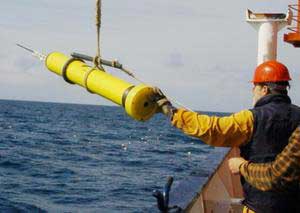More than 3,600 robots probe the seas down to 2,000 meters
Scientists worldwide have been capturing and analyzing detailed data about the atmosphere for decades. Information about the oceans has been much more spotty, however. Ships have taken readings along many isolated transects, but each effort has occurred at a moment in time, and significant portions of the seas have gone unexamined.
That is changing. Since 2007 a network of thousands of floating robots covering the seven seas, named Argo, has been generating real-time data for use in ocean and climate research. Each robot probe, a tube a little more than meter long, dives to about 1,000 meters, then drifts locally for nine days. On the 10th day it sinks to 2,000 meters and then rises straight up, sensing temperature and salinity along its ascent. Each probe also measures the subsurface and surface currents that push it around. When a probe surfaces, a satellite picks up the data, and the probe sinks again for another 10-day cycle.
Each robot uses a hydraulic piston and bladder to dive and surface and lasts about five years. From 700 to 800 new units have been deployed in each of the past several years to replace defunct robots or to beef up the network in remote regions to improve global coverage.
The Argo program, named after the mythical Greek ship, is run by 50 research institutions in more than 30 countries.








